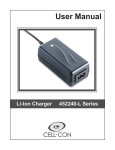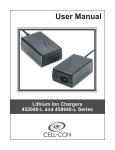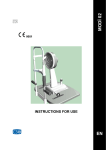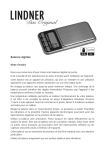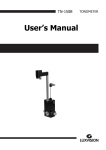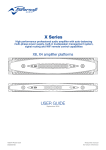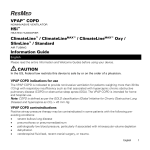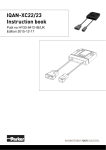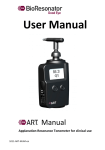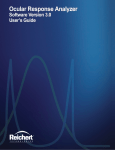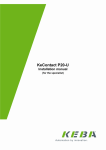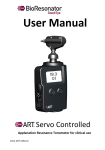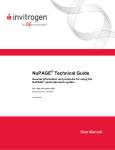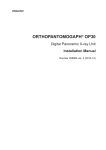Download POLARIS EN
Transcript
POLARIS 90000013 r e v. 0 0 0 03/2014 INSTRUCTIONS FOR USE EN INSTALLAZIONE INSTRUCTIONS FOR USE CONTENTS 1. General warnings............................................................................................................. 4 1.1.Symbols.................................................................................................................................. 4 1.2. Intended use and operating procedures................................................................ 5 1.2.1.Classification...................................................................................................................... 5 1.2.2. Environmental conditions.............................................................................................. 5 1.2.3. REFERENCE STANDARDS....................................................................................................... 6 1.2.4Warranty............................................................................................................................... 7 1.3. Safety warnings................................................................................................................. 8 1.4.Disposal at the end of life............................................................................................. 9 2. SUPPLY PACKAGE................................................................................................................. 10 2.1LEGEND................................................................................................................................... 10 2.2 Films Kit................................................................................................................................. 11 2.3 IDENTIFICATION NAMEPLATE............................................................................................... 12 3. ROUTINE MAINTENANCE...................................................................................................... 12 4.USAGE..................................................................................................................................... 13 5. TECHNICAL FEATURES......................................................................................................... 18 6. Guidance and manufacturer’s declaration ....................................................... 19 6.1 electromagnetic emission.......................................................................................................... 19 6.2 electromagnetic immunity........................................................................................... 20 INSTALLATION B1. INSTALLATION AND COMMISSIONING ................................................................................ 22 B2. INSERTING OR REPLACING GRID FILMS............................................................................ 23 B3. INSTALLING POLARIS ON A CSO SLIT LAMP....................................................................... 24 3 IT INSTRUCTIONS FOR USE 1. General warnings • These instructions describe how to use the CSO Polaris Tear Film Examination System correctly. WARNING! Please carefully read this manual before using the device. All CSO products have been manufactured with the greatest attention to functionality and safety. In particular, POLARIS is a high-performance. system. To use the device effectively and safely, please read this user manual carefully before installing and using the device, and follow the instructions and warnings reported in the manual and on the device. Operators who have used the device previously, should check again the instructions reported in this manual. The manual must be readily available for consultation. The original text of this manual is in Italian. 1.1.Symbols Explanation of Symbols: 1) Type B applied parts, in compliance with EN 606011 standards. 2) Class II device (in compliance with EN 60601-1 standards). This means that the isolation from the mains supply is highly reliable, therefore no safety earthing connection is necessary. 3)General Warning indicating the need to carefully read the user manual before installing and using the device. 4) "CE marking", indicates that the product is compliant with the EC Directive 93/42/EEC and subsequent amendments 5)Disposal symbol incompliance with Directives 2002/95/EC, 2002/96/EC and 2003/108/EC. 6)Manufacturer. IT 4 INSTRUCTIONS FOR USE 1.2. Intended use and operating procedures Polaris enables detailed examination of the tear film characteristics. More specifically, with Polaris you can: • • • • assess the lipid film quality and quantity measure the inferior tear layer assess the tear film stability and regularity assess the corneal surface regularity All the exams described above are performed with completely non-invasive methods and do not require any stainer to be diluted in the tear film. Polaris consists of a diffused light source which replaces the slit lamp lighting system. Polaris is used as an accessory to the biomicroscope. Polaris' light source is a LED light, namely a cold light which induces neither excessive lachrymation nor evaporation in the patient examined. The image projected by Polaris and reflected on the tear film is observed through the biomicroscope. 1.2.1.Classification • MEDICAL DEVICE classification device classification in accordance with the rules set out in Annex IX of Directive 93/42/EC and subsequent amendments: Class I. • ELECTROMEDICAL DEVICES Classification. Type of protection against direct and indirect contact: Class II (*). Applied Parts: Type B. Degree of protection against humidity: Common device (no protection against water seepage) IP20. Sterilization method: Disinfectable device. Degree of protection when used with anaesthetics or flammable detergents: No protection. Degree of electrical connection between the device and the patient: Device with parts applied to the patient. POLARIS are class II devices, therefore the earth connection and the socket earth serve as functional earth. 1.2.2.Environmental conditions As long as the device is kept in its original packaging, it can be exposed to the following environmental conditions without being damaged, and for a maximum period of 15 weeks during shipping and storage: Operating conditions of use: Temperature between +10 °C and +35 °C; Atmospheric pressure 800 hPa to 1060 hPa; Relative humidity between 30% to 90%. Storage conditions: Temperature between -10 °C and +55 °C; Atmospheric pressure 700 hPa to 1060 hPa; Relative humidity 10% to 95%. Transport conditions: Temperature -40 °C to +70 °C; Atmospheric pressure 500 hPa to 1060 hPa; Relative humidity 10% to 95%. Vibration, sinewave 10 Hz to 500 Hz, 0.5g Shock 30g, time: 6ms Bumb 10g. time: 6ms 5 IT INSTRUCTIONS FOR USE 1.2.3.REFERENCE STANDARDS The following reference standards have been applied for product design, production and control: Community Directives • DIRECTIVE 93/42/EEC “MEDICAL DEVICES” OF 14/06/1993 AND SUBSEQUENT AMENDMENTS • DIRECTIVE 2002/96/EC “Waste Electrical and Electronic Equipment”. Quality Management System Standards • UNI EN ISO 9001:2008 “Quality management systems - Requirements” • UNI EN ISO 13485:2012 “Medical devices - Quality Management Systems - Regulatory Requirements” Technical Standards • EN 60601:1 STANDARDS - “PART 1: MEDICAL ELECTRICAL EQUIPMENT: GENERAL REQUIREMENTS FOR SAFETY", third edition; • EN 60601-1-2 - “Collateral standard: Electromagnetic Compatibility of Medical Electrical Equipment, 2007 edition; • UNI EN ISO 15004-1: “Ophthalmic Instruments - Fundamental Requirements and Testing Methods Part 1: General requirements applicable to all Ophtalmic Instruments", 2009 edition; • UNI EN ISO 15004-2: “Ophthalmic Instruments - Fundamental Requirements and Testing Methods Part 2: Protection against light-related hazards", 2007 edition; • UNI EN ISO 14971: 2012 "Application of risk management to medical devices” IT 6 INSTRUCTIONS FOR USE 1.2.4Warranty CSO S.r.l. is liable for the device being in compliance with the Community Directive 93/42/EEC as amended by 2007/47/EC, as well as for the device performance, safety and reliability, and consequently for the CE marking. CSO S.r.l. will not be liable under the following circumstances: • installation and commissioning are carried out without following the instructions and precaution warnings reported in the manual; • the device is not used following the instructions and precaution warnings reported in the manual; • accessories or spare parts are used other than those supplied or recommended by CSO S.r.l.; • repairs and safety controls are not carried out by skilled, qualified personnel, trained and authorised by CSO S.r.l.; • the electric system of the location where the device is installed does not comply with CEI standards and the law requirements in force. CSO S.r.l. accepts no liability for direct or indirect consequences or for damages to property or harm to persons caused by the improper use of the device or by unsound clinical assumptions based on its use. CSO S.r.l. warrants this product for a period of 24 months as stated by the date of manufacturing. This warranty covers the replacement, at CSO premises or at an authorised service centre, of components and materials, as well as the necessary working hours. Shipping and transportation charges shall be born by the customer. This warranty does not cover consumable parts or parts likely to wear in normal operation or parts damaged due to improper use or to maintenance carried out by personnel not authorised by CSO. OUT OF WARRANTY CONDITIONS • Repairs of faults caused by natural disasters, mechanical shock (fall, impact, etc.), defects of the electrical system, neglect, improper use, maintenance or repairs carried out with non original material and/or by personnel not authorised by CSO S.r.l. • Any use which is improper or falling out of the intended use as foreseen by the manufacturer. CSO S.r.l. shall not be liable for any service deficiencies or inefficiencies due to causes or circumstances beyond its reasonable control. Under no circumstances, shall the customer be entitled to down time damages. For maintenance or technical information on the device, please contact one of CSO Technical Service Centres or CSO directly at: CSO srl Costruzione Strumenti Oftalmici Via degli Stagnacci, 12/E 50018 Badia a Settimo Scandicci (FI) - ITALY Phone: 039(0)55-722191 - FAX 039(0)55-721557 Email: [email protected] www.csoitalia.it 7 IT INSTRUCTIONS FOR USE 1.3. Safety warnings WARNING! • Do not touch the computer mains power cable with wet hands; make sure the mains power cable is not walked on or trapped under weights; do not tie the mains power cable. • The power source must have a differential circuit breaker (IΔn= 30 mA) and a thermal magnetic circuit breaker(Vn=230V) to protect the device. The power socket must be close and easily accessible. • A damaged power cable can cause fire or electric shock. It must be checked frequently. If the supplied computer power cable needs to be replaced, please contact the supplier. • Do not attempt to carry out any technical intervention on the device or on the system unless specified in this manual. • Do not use the device in the proximity of water and avoid liquid spillage on any surface of the device. Avoid humid or dusty places or places which are subject to rapid fluctuations in temperature and humidity. • Unplug the device from the power socket before cleaning and/or disinfecting. • The device does not generate or receive electromagnetic interferences when operated near other devices; no preventive or corrective action is necessary. • No precautions are necessary in case of any changes affecting the device performance. • In addition to the image capturing system, the device includes non electromedical appliances (Personal Computer, monitor, etc.). The standard configuration of the system supplied by CSO complies with EN 60601:1 standards (3rd edition), especially as per the requirements in chapter 16 of said standards. In addition to its standard configuration, the system can operate with other appliances (electromedical and not), therefore CSO could not verify compliance with the standards of all possible configurations. • The configuration verified by CSO Srl is the one with the Personal Computer outside of the patient's area. - Any peripheral device (printer, scanner, CD player, etc) connected to the analogical or digital interface of the system must comply with the following standards: - EN: 60950-1 for ITE equipment (safety standards for information technology equipment ); or - EN 60601:1 for medical electrical equipment; The peripheral devices must be connected outside the patient's area. • After connecting all the peripheral devices, the user is responsible for regularly verifying compliance of the electromedical system with EN 60601:1 standards (the specific requirements are reported in chapter 16 of the standards). • If leakage current values exceed regulatory limits, further safety measures must be adopted, as indi- IT THE PERSONAL COMPUTER AND ALL PERIPHERAL DEVICES SHOULD BE PLACED OUTSIDE THE PATIENT AREA The patient area is the volume defined as shown in the figure, within which the patient may come into contact (intentionally or unintentionally, directly or through contact with the operators) with medical electrical and other devices making up the system 8 INSTRUCTIONS FOR USE cated in the EN 60601:1 standards (3rd edition). In this case, the overall system must be powered through an adequate separator or isolation transformer . - The transformer is absolutely necessary in case the operators cannot easily keep the computer and other non-electromedical appliances outside of the patients' area. WARNING! Only units with CSO trademark can be placed and used in the patient's area. The following parts of the system must instead be placed outside the patient's area: • Computer (desktop or laptop), with any peripheral device (monitor, keyboard, mouse, etc.); • Printers; • Other non-electromedical auxiliary devices (supply units/battery chargers, UPS, modem, etc.). If the system needs to be connected to a computer network (LAN) all the necessary measures must be adopted to prevent transfer of dangerous voltage from remote stations, through the connected cables. The use of data transfer devices ensuring "GALVANIC ISOLATION" may be necessary. CSO Srl shall not be held liable in relation to the patient and operator's safety in the case of electrical connections between the computer and other external units (peripherals) or LAN networks which are not made by CSO Srl itself. 1.4.Disposal at the end of life Under Directives 2002/95/EC, 2002/96/EC and 2003/108/EC, on the restriction of hazardous substances in electrical and electronic equipment and on their disposal”. The device purchased is manufactured using special materials and substances. The device may contain hazardous substances potentially harmful to the environment or to human health if improperly disposed of into the environment. To prevent any hazardous substances from being discharged into the environment and to promote the conservation of natural resources, the manufacturer -should the user want to get rid of the used device at endof-life- facilitates the possible reuse of the device and the recovery and recycling of its materials. Public authorities adopt adequate measures to make sure that users, distributors and manufacturers contribute to the collection of electrical and electronic equipment, setting legal requirements for reusing, recovering or recycling said equipment. In the case of disposal of the device, specific provisions of European and national law apply, and provide that: • the device shall not be disposed of as urban waste, it shall be collected separately, by contacting a company specialising in the disposal of electrical/electronic equipment or the public authorities responsible for waste management; • in the event that a new piece of equipment is purchased from the same manufacturer to replace an old one placed on the market before 13 August 2005, equivalent and with the same functions of the new equipment, the distributor or manufacturer is legally required to collect the old piece of equipment; • if the user wants to get rid of a used piece of equipment, placed on the market after 13 August 2005, the distributor or manufacturer is legally required to collect it; • the manufacturer shall take care of the transport, handling, recovery and/or disposal of the old equipment collected at its own charge; • the potentially harmful effects to the environment or human health due to any hazardous substance contained in electrical and electronic equipment or to the improper use of said equipment or its parts shall be taken into account. The device described in this user manual is made of metal mechanical components, plastic material, electrical components and electronic boards. The manufacturer will provide the users with any information regarding the hazardous substances contained in the device and on the recovery and recycling of said substances, as well as on the possible reuse of the used device. Violations shall be punished by the current legislation with serious administrative sanctions. 9 IT INSTRUCTIONS FOR USE 2. SUPPLY PACKAGE The system is composed of the following main units: topographic unit, designed and manufactured by CSO, composed of: 1.Tear film kit Accessories supplied The system is supplied with the following accessories: • films kit • instrument case • user manual This instrument can be used as an accessory to CSO slit lamps. The external power supply unit for use without the computer is not supplied by CSO. 2.1LEGEND 1) Lamp mount 2) Fix arm 3) Instrument lighting head 4) Grid film 5) ON/OFF button 6) USB power stick 7) Movable arm 8) Lamp clamping nut 9) Nameplate 5 4 7 3 2 6 8 1 9 IT 10 INSTRUCTIONS FOR USE 2.2 Films Kit The films kit supplied is composed of 3 different grids: • • • Fine grid Placido's disk Negative grid FINE GRID For grids functionality and use please see the instructions for use paragraph. PLACIDO’S DISK NEGATIVE GRID 11 IT INSTRUCTIONS FOR USE 2.3 IDENTIFICATION NAMEPLATE Data reported on the nameplates: • Manufacturer’s name. • Device name. • Serial number. • Month and year of manufacture. 3. ROUTINE MAINTENANCE The system does not require any particular routine maintenance operations by the user. To clean the external surfaces simply use a cloth slightly dampened with water. Protection against dust When not in use, protect the system against dust by placing it back in its case. Dust accumulating on the device must be regularly removed with a soft cloth or blower. Other maintenance operations (repairs, components replacement, assessment of internal components, etc.) fall within the exclusive competence of CSO Technical Service. Warning. The manufacturer agrees to provide, upon motivated request: diagrams, lists of components, specific technical instructions which might be useful to authorized and pre-trained personnel for maintenance and calibration. WARNING! Do not use any thinners or solvents. WARNING! If the product needs maintenance, contact the Technical Service authorised by CSO Srl. IT 12 INSTRUCTIONS FOR USE 4.USAGE TEAR FILM EXAMINATION Examination procedure During the exam, the patient will have his/her head against the chinrest of the slit lamp, as in regular examination with biomicroscope. The slit lamp lighting system must be slightly displaced laterally and turned off. Polaris is positioned on the slit lamp, using the tonometer support and it must be kept as close to the eye as possible. The closer Polaris is to the eye, the larger the instrument-illuminated area is. Light reflected by the tear film will be visualized as a white circular area covering the cornea almost entirely. The observation system is positioned so as to allow examination through Polaris central hole, using one of the biomicroscope lenses. At the beginning, a lower magnification is recommended, with the possibility to increase magnification later for detailed examination of the interferometric images and tear layer in detail. Lipid film examination Polaris enables interferometric examination of the lipid layer of the tear film. The biomicroscope must be focused on the tear film, while the diffused light image projected by Polaris remains out of focus. Depending on its thickness and regularity, the lipid layer may appear like any of the following: amorphous structure, marble appearance, wavy appearance, yellow, brown, blue or reddish interference fringes. The following figures show some interferometric images. 13 IT INSTRUCTIONS FOR USE Height of the inferior tear layer Most tears are collected in the inferior and superior tear layer. The size of the tear layer formed on the eyelid borders provides useful information on the volume of tears produced. The tear layer can be examined taking into account its height, regularity and shape. Gradation is not accurate when there are reflected tears. Polaris' Brightness is calibrated so as not to cause any glare in the patient examined, besides, the light being cold it does not induce excessive reflected lachrymation. Polaris allows you to highlight shape and height of the tear layer without using any staining, hence without altering tear composition. A standard tear layer is convex near the eyelid margin and concave at the centre (See Fig. n). The standard tear layer, observed with Polaris, presents with a typical black line near the convex part of the layer profile (See Fig. n). Proper tear layer profile. IT 14 INSTRUCTIONS FOR USE Proper tear layer profile. Image of a tear layer illuminated by Polaris: the image shows a proper tear layer 15 IT INSTRUCTIONS FOR USE Inadequate tear layer profile Irregular and lowered tear layer Tear film stability and regularity Polaris allows you to assess stability and regularity of the tear film, using non-invasive break up time measurement (NIBUT). Indeed, grids can be inserted inside Polaris' internal cylinder to project structured images on the tear film surface. By examining the regularity of the image reflected by the tear film the tear film NIBUT can be measured. The non-invasive break up time is the measurement, in seconds, of the time between the last complete blinking and the appearance of the first discontinuity on the tear film. Polaris can also be used to observe the pre-rupture phase indicating tear film thinning time. These measurements can be taken with or without contact lenses. For accurate measurement, the patient must be properly instructed. During the exam, the patient must look in front of him/her and is encouraged to slightly blink. Then, he/she is asked to keep his/her eyes open, without blinking for as long as possible. The seconds between the last full blinking and the first rupture of the image reflected on the tear film are counted with a chronometer. IT 16 INSTRUCTIONS FOR USE NIBUT measuring grid Image irregularities indicate an irregular and discontinuous tear film. Cornea regularity Polaris can also be used to assess the regularity of the corneal profile. By inserting the specific grids inside the internal cylinder of the instrument, a series of concentric rings is projected onto the cornea thus performing a keratoscopy. If the corneal surface is regular, the concentric rings will all be at the same distance. Any irregularities in the surface of the cornea will result in irregularities of the reflected image. Closer rings correspond to steeper areas of the cornea, while rings farther apart correspond to flatter areas. 17 IT INSTRUCTIONS FOR USE Anelli più vicini corrispondono a zone di cornea più curve, mentre anelli più lontani corrispondono a zone di cornea più piatte. 5. TECHNICAL FEATURES Device Power supply LED lighting source Weight Size ( HxWxD) mm Computer connection Manual IT 5 V - 100 mA White LED 300 g (217 x 22 x 74.5) mm USB cable Alignment 18 INSTRUCTIONS FOR USE 6. Guidance and manufacturer’s declaration 6.1 electromagnetic emission Table 1-Guidance and manufacturer’s declaration – electromagnetic emission The equipment POLARIS is intended for use in the electromagnetic environment specified below. The customer or the end user of the POLARIS should assure that it is used in such an environment. Emission test compliance Electromagnetic environment - guidance RF emission – CISPR 11 Group 1 RF emission – CISPR 11 Class B Harmonic emission IEC 61000-3-2 Class A Voltage fluctuation/flicker emission IEC 61000-3-3 Complies The POLARIS uses RF energy only for its internal function. Therefore its emissions are very low and are not likely to cause any interference in nearby electronic equipment The POLARIS is suitable for use in all establishments including domestic establishments and those directly connected to the public low voltage power supply network that supplies buildings used for domestic purposes The POLARIS is suitable for use in all establishments including domestic establishments and those directly connected to the public low voltage power supply network that supplies buildings used for domestic purposes The POLARIS is suitable for use in all establishments including domestic establishments and those directly connected to the public low voltage power supply network that supplies buildings used for domestic purposes 19 IT INSTRUCTIONS FOR USE 6.2 electromagnetic immunity. Table 2 -Guidance and manufacturer’s declaration – electromagnetic immunity The equipment POLARIS is intended for use in the electromagnetic environment specified below. The customer or the end user of the POLARIS should assure that it is used in such an environment. Immunity test IEC 60601 Compliance Electromagnetic environment Test level level guidance Electrostatic discharge (ESD) IEC 61000-4-2 ±6 KV contact ±8 KV air ±6 KV contact ±8 KV air Electrical Fast Transient/Burst IEC 61000-4-4 ±2 KV for power supply lines ±1 KV for I/O lines ±2 KV for power supply lines Not applicable Surge IEC 61000-4-5 ±1 KV differential mode ±2 KV common mode ±1 KV differen- Mains power quality should be tial mode that of a typical commercial or ±2 KV common hospital environment mode Voltage Dips, Short interruptions and voltage variations on power supply input lines IEC 61000-4-11 <5% Ut for 0,5 cycle 40% Ut for 5 cycles 70% Ut for 25 cycles <5% Ut for 5 sec <5% Ut for 0,5 cycle 40% Ut for 5 cycles 70% Ut for 25 cycles <5% Ut for 5 sec Mains power quality should be that of a typical commercial or hospital environment. If the user of the POLARIS requires continued operation during power mains interruptions, it is recommended that the POLARIS be powered from an Uninterruptible Power Supply or Battery Power frequency (50/60Hz) magnetic field IEC 61000-4-8 3 A/m 3 A/m Power frequency magnetic fields should be at levels characteristic of a typical location in a typical commercial or hospital environment Note: Ut is the AC mains voltage prior to application of the test level IT 20 Floors should be wood, concrete or ceramic tile. If floors are covered with synthetic material, the relative humidity should be at least 30% Mains power quality should be that of a typical commercial or hospital environment INSTRUCTIONS FOR USE Table 3- Guidance and manufacturer’s declaration – electromagnetic immunity The equipment POLARIS is intended for use in the electromagnetic environment specified below. The customer or the end user of the POLARIS should assure that it is used in such an environment Immunity test IEC 60601 Compliance Electromagnetic environment - guidanTest level level ce Portable and mobile RF communication equipment should be used no closer to any part of the POLARIS, including cables, than the recommended separation distance calculated from the equation applicable to the frequency of the transmitter. Conducted RF IEC 61000-4-6 Radiated RF IEC 61000-4-3 3Vrms 150KHz to 80MHz 3V/m 80 MHz to 2,5 GHz 3 V rms Recommended separation distance. d=1,167*sqrt (P) 3 V/m d=1,167*sqrt (P) 80 MHz to 800 MHz d=2,333*sqrt(P) 800 MHz to 2,5 GHz Where P is the maximum output power rating of the transmitter in watts(W) according to the transmitter manufacturer and d is the recommended separation distance in metres (m) Field strengths from fixed RF transmitters, as determined by an electromagnetic site survey, should be less than the compliance level in each frequency range. Interference may occur in the vicinity of equipment marked with the following symbol: Note 1: at 80 MHz and 800 MHz, the higher frequency range applies Note 2: These guidelines may not apply in all situations. Electromagnetic propagation is affected by absorption and reflection from structures, objects and people. 21 IT INSTALLATION B1. INSTALLATION AND COMMISSIONING All equipment composing the system is always delivered packaged in optimal conditions to withstand standard transport and storage conditions. In the event that, when removing the device from its packaging, damages due to transport are detected, please contact the installer company or the manufacturer directly. To power the instrument, connect the USB power stick (6) to a USB port on the computer (6A) 6 6A An external power supply unit can also be used (6B) (optional) compliant with EN 60950 standards 6 IT 22 6B INSTALLATION B2. INSERTING OR REPLACING GRID FILMS. To insert or replace grid films (4) proceed as follows: 1) Wrap the film (4) 2) Shape it like a cone (4A) 3) Insert the cone inside the light head (3). 4 4A 3 The upper structure of the device (7) can move forwards or backwards to help focusing, and to adjust to the patient's facial morphology. 7 23 IT INSTALLATION B3. INSTALLING POLARIS ON A CSO SLIT LAMP. The figures below show how to assemble POLARIS on a CSO slit lamp. Insert the lamp mount (1) as shown in the figure and point the lighting head (3) facing the patient. Align the instrument with the lamp microscope. IT 24
























